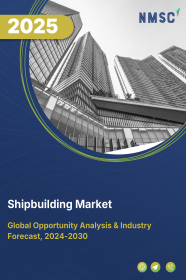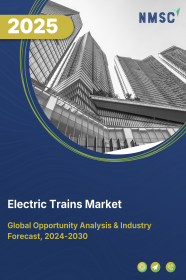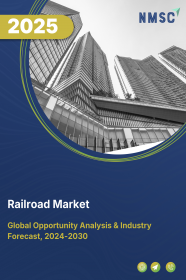
Shipbuilding Market by Ship Type (Cargo, Vessel, Container, Tanker, Multi-Purpose Ship, Car and Passenger Ferry, and Others), by Process (Designing, Production Planning, Cutting and Processing, Assembling and Launching, and Outfitting), by Propulsion (Conventional Propulsion (Diesel Engines), Gas Turbine Propulsion, Nuclear Propulsion, and Electric & Hybrid Propulsion), and by End-User (Commercial and Military) – Global Opportunity Analysis and Industry Forecast, 2025-2030
US Tariff Impact on Shipbuilding Market
Trump Tariffs Are Reshaping Global Business
Shipbuilding Market Overview
The Global Shipbuilding Market size was valued at USD 163.66 billion in 2024 and is expected to be valued at USD 170.51 billion by the end of 2025. The industry is further predicted to reach USD 203.14 billion by 2030 with a CAGR of 3.6% from 2025 to 2030.
The shipbuilding market is driven by key factors such as government initiatives, global trade growth, and the rising demand for green shipping technologies. However, challenges related to cost competitiveness, especially for emerging ship manufacturing nations, hinder market progress. On the other hand, opportunities lie in the adoption of digitalization and automation technologies, which improve production efficiency and help shipbuilders stay competitive.
Government Initiatives Fueling the Market Growth
The shipbuilding industry is receiving a significant boost from proactive government policies and substantial financial support. Recognizing the economic and strategic importance of a strong domestic ship manufacturing industry, governments are introducing measures to foster growth and enhance competitiveness. For instance, the Indian government has launched a Maritime Development Fund (MDF) with a substantial corpus of USD 2.87 billion in the Union Budget 2025. This fund aims to promote infrastructure development and improve the competitiveness of the maritime sector. Furthermore, initiatives like the ship manufacturing Financial Assistance Policy are designed to provide shipbuilders with easier access to infrastructure credit. The extension of customs duty exemptions for raw materials and parts used in ship manufacturing for another decade also provides crucial cost relief. These governmental endeavours act as powerful driving factors, injecting much-needed capital and creating a favourable policy environment for the expansion of the shipbuilding industry and enhancing its market share in the global landscape.
Growth of Global Trade and Maritime Oil Transport Boosts the Market Expansion
The sheer volume of global trade traversing maritime routes acts as a major driver for the shipbuilding market. The Indian Ocean Region (IOR), for example, holds immense strategic importance, with approximately 80% of the world’s maritime oil trade and about 40% of the world’s total trade by volume passing through it annually. India’s central location in the IOR positions its ship manufacturing industry as a crucial element in maintaining the security and stability of these vital sea lanes, which are essential for international trade and energy transport. As global trade continues to expand, the demand for new and efficient vessels to facilitate this movement will also rise, directly fueling the growth potential of the ship manufacturing industry. This reliance on seaborne trade underscores the fundamental role of ship manufacturing in the global economy and its inherent industry size.
Environmental Sustainability and Green Shipping Drives the Market Growth
The increasing global focus on environmental sustainability and the urgent need to reduce greenhouse gas emissions are drivers reshaping the ship manufacturing market. The maritime industry is under growing pressure to adopt cleaner technologies and fuels. This demand for green shipping is pushing shipbuilders to innovate and design vessels capable of running on alternative fuels like LNG, ammonia, and even hydrogen. Initiatives promoting energy efficiency through advanced hull designs, hybrid and electric propulsion systems, and wind-assisted propulsion are becoming increasingly important. For example, Cochin Shipyard Limited (CSL) in India is already constructing autonomous electric ferries and zero-emission vessels, demonstrating the industry's capacity to adapt to this trend. The development and adoption of emission control technologies like scrubbers and selective catalytic reduction (SCR) systems are also crucial in meeting stringent environmental regulations. This global shift towards sustainability presents a significant growth potential for the shipbuilding industry to develop and market environmentally friendly vessels, thereby influencing future market trends and potentially increasing market share for pioneers in this domain.
Cost Competitiveness Challenges Hinders the Market Growth
A significant restraint for the shipbuilding industry, particularly for nations aspiring to become major players, is the challenge of cost competitiveness. Compared to established ship manufacturing powerhouses, emerging markets often face disadvantages related to the cost of materials, labour, and infrastructure. For example, an article from The Economic Times highlighted cost disadvantages as a key challenge for India's ship manufacturing industry. Despite government support and financial assistance schemes, local shipyards may struggle to compete with the often-lower production costs in countries like China, South Korea, and Japan. Overcoming this restraint requires concerted efforts to improve efficiency, develop domestic supply chains to reduce reliance on potentially expensive imports, and leverage technological advancements to optimize production processes. Failure to address cost competitiveness can hinder the growth potential and limit the market share that emerging ship manufacturing nations can capture in the global industry size.
Adoption of Digitalization and Automation Technologies Creates Future Opportunities
The integration of robotics, automation, and 3D printing (additive manufacturing) in shipbuilding processes is enhancing efficiency, precision, and production speed. Shipyards adopting smart manufacturing solutions and digital twins can reduce costs and attract clients seeking modern, efficient vessels. Major shipyards are implementing automated systems and forming partnerships with technology providers to leverage advanced manufacturing capabilities. For instance, BAE Systems Australia trialed laser scanning technology in 2023 to create 3D models for naval frigates, a trend likely to expand in 2025. Adoption of such automation technologies is anticipated to create lucrative opportunities for the market expansion.
Market Segmentations and Scope of the Study
The shipbuilding market report is segmented based on ship type, process, propulsion, end-user, and region. By ship type, the market is categorized into cargo ships, vessels, container ships, tankers, multi-purpose ships, car and passenger ferries, and others. Based on process, it is divided into designing, production planning, cutting and processing, assembling and launching, and outfitting. By propulsion type, the market includes conventional propulsion (diesel engines), gas turbine propulsion, nuclear propulsion, and electric and hybrid propulsion. On the basis of end-user, the market is segmented into commercial and military sectors. Regional breakdown and analysis of each of the aforesaid segments include regions comprising North America, Europe, Asia-Pacific, and RoW.
Geographical Analysis
Asia-Pacific region holds a dominating position in the global shipbuilding industry. Nations like China, South Korea, and Japan have historically dominated in terms of market size and market share, often boasting full order books stretching years into the future. This concentration of ship manufacturing capacity in Asia-Pacific signifies a mature industry with established expertise and infrastructure. However, this dominance also presents an opportunity for other regions to emerge and capture a larger slice of the ship manufacturing pie, especially considering factors like geopolitical diversification.
Europe, on the other hand, presents a different picture. While facing competition from Asia, the European shipbuilding and maritime technology sector maintains a strong base in specialized vessel types. There's a focus on high-quality products, new designs, and technological innovation. The region benefits from a strong research environment and skilled workforce. However, European shipbuilders contend with challenges such as higher production costs and competition from state-supported Asian players. The European Union's Green Deal and industrial policy are also significant factors shaping the market trends here, driving demand for more energy-efficient and sustainable vessels.
In North America, the shipbuilding industry has a significant focus on national security considerations and naval defense readiness. While perhaps not having the same market size as Asia for commercial shipbuilding, there's a strategic emphasis on domestic capabilities. Trends here might be more closely tied to government spending and defense contracts.
The Rest of the World category encompasses various nations with developing or niche shipbuilding industries. There's growth potential in these regions, often driven by local demand and strategic government initiatives. For instance, India has expressed strong ambitions to become a significant player in the global ship manufacturing industry, aiming to increase its market share and become a top 10 ship manufacturing nation by 2030. Investments in infrastructure, technology, and international collaborations are key to unlocking the growth potential in the shipbuilding sector in the region.
Strategic Adaptations by Key Players Drive Industry Evolution
The global shipbuilding industry's key players are strategically adapting to evolving market trends and challenges through various means. A significant recent development is that major ship manufacturing nations like China, South Korea, and Japan are experiencing full order books extending up to 2028, indicating a high current market size and potentially shifting market share dynamics. In response to this capacity crunch and geopolitical factors, companies like HD Korea ship manufacturing & Offshore Engineering (HD KSOE) are extending their global reach by utilizing overseas dockyards such as the revived Subic Shipyard in the Philippines. This exemplifies a strategy of geographical diversification to stay ahead of rivals and respond to global trade shifts. Furthermore, international collaborations are becoming increasingly vital, as seen with India actively courting South Korean and Japanese shipbuilders for technology and know-how. For instance, Cochin Shipyard Limited (CSL) has partnered with Fincantieri of Italy for technology transfer.
KEY BENEFITS
-
The report provides quantitative analysis and estimations of the shipbuilding industry from 2025 to 2030, which assists in identifying the prevailing market opportunities.
-
The study comprises a deep dive analysis of the shipbuilding market including the current and future trends to depict prevalent investment pockets in the market.
-
Information related to key drivers, restraints, and opportunities and their impact on the shipbuilding market is provided in the report.
-
Competitive analysis of the players, along with their market share is provided in the report.
-
SWOT analysis and Porters Five Forces model is elaborated in the study.
-
Value chain analysis in the market study provides a clear picture of roles of stakeholders.
Shipbuilding Market Key Segments
By Ship Type
-
Cargo
-
Vessel
-
Container
-
Tanker
-
Multi-Purpose Ship
-
Car and Passenger Ferry
-
Others
By Process
-
Designing
-
Production Planning
-
Cutting and Processing
-
Assembling and Launching
-
Outfitting
By Propulsion
-
Conventional Propulsion (Diesel Engines)
-
Gas Turbine Propulsion
-
Nuclear Propulsion
-
Electric and Hybrid Propulsion
By End-User
-
Commercial
-
Military
By Region
-
North America
-
The U.S.
-
Canada
-
Mexico
-
-
Europe
-
The UK
-
Germany
-
France
-
Italy
-
Spain
-
Denmark
-
Netherlands
-
Finland
-
Sweden
-
Norway
-
Russia
-
Rest of Europe
-
-
Asia Pacific
-
China
-
Japan
-
India
-
South Korea
-
Australia
-
Indonesia
-
Singapore
-
Taiwan
-
Thailand
-
Rest of Asia Pacific
-
-
RoW
-
Latin America
-
Middle East
-
Africa
-
Key Players
-
HD Hyundai Heavy Industries Co., Ltd.
-
China State Shipbuilding Corporation (CSSC)
-
FINCANTIERI S.p.A.
-
Samsung Heavy Industries Co., Ltd.
-
Hanwha Ocean Co., Ltd.
-
Sumitomo Heavy Industries Marine & Engineering Co., Ltd.
-
Mitsubishi Shipbuilding Co., Ltd.
-
Mazagon Dock Shipbuilders Limited
-
Cochin Shipyard Limited
-
JSC United Shipbuilding Corporation
-
Damen Shipyards Group
-
BAE Systems
-
Imabari Shipbuilding Co., Ltd.
-
Garden Reach Shipbuilders & Engineers Ltd.
-
Hindustan Shipyard Limited
REPORT SCOPE AND SEGMENTATION
|
Parameters |
Details |
|
Market Size in 2024 |
USD 163.66 Billion |
|
Revenue Forecast in 2030 |
USD 203.14 Billion |
|
Growth Rate |
CAGR of 3.6% from 2025 to 2030 |
|
Analysis Period |
2024–2030 |
|
Base Year Considered |
2024 |
|
Forecast Period |
2025–2030 |
|
Market Size Estimation |
Billion (USD) |
|
Growth Factors |
|
|
Countries Covered |
28 |
|
Companies Profiled |
15 |
|
Market Share |
Available for 10 companies |
|
Customization Scope |
Free customization (equivalent up to 80 working hours of analysts) after purchase. Addition or alteration to country, regional, and segment scope. |
|
Pricing and Purchase Options |
Avail customized purchase options to meet your exact research needs. |

















 Speak to Our Analyst
Speak to Our Analyst



















